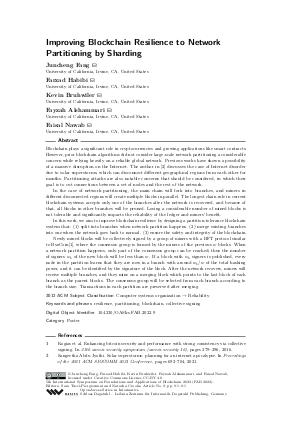Improving Blockchain Resilience to Network Partitioning by Sharding (Poster)
Authors Juncheng Fang, Farzad Habibi, Kevin Bruhwiler, Fayzah Alshammari, Faisal Nawab
-
Part of:
Volume:
5th International Symposium on Foundations and Applications of Blockchain 2022 (FAB 2022)
Part of: Series: Open Access Series in Informatics (OASIcs)
Part of: Conference: International Symposium on Foundations and Applications of Blockchain (FAB) - License:
 Creative Commons Attribution 4.0 International license
Creative Commons Attribution 4.0 International license
- Publication Date: 2022-06-21
File

PDF
OASIcs.FAB.2022.9.pdf
- Filesize: 227 kB
- 1 pages
Document Identifiers
Subject Classification
ACM Subject Classification
- Computer systems organization → Reliability
Keywords
- resilience
- partitioning
- blockchain
- collective signing
Metrics
- Access Statistics
-
Total Accesses (updated on a weekly basis)
0Document
0Metadata
Abstract
Blockchain plays a significant role in cryptocurrencies and growing applications like smart contracts. However, prior blockchain algorithms did not consider large-scale network partitioning a considerable concern while relying heavily on a reliable global network. Previous works have shown a possibility of a massive disruption on the Internet. The author in [Jyothi, 2021] discusses the case of Internet disorder due to solar superstorms, which can disconnect different geographical regions from each other for months. Partitioning attacks are also notable concerns that should be considered, in which their goal is to cut connections between a set of nodes and the rest of the network. In the case of network partitioning, the main chain will fork into branches, and miners in different disconnected regions will create multiple blocks in parallel. The longest chain rule in current blockchain systems accepts only one of the branches after the network is recovered, and because of that, all blocks in other branches will be pruned. Losing a considerable number of mined blocks is not tolerable and significantly impacts the reliability of the ledger and miners' benefit. In this work, we aim to improve blockchain resilience by designing a partition-tolerance blockchain system that: (1) split into branches when network partition happens. (2) merge existing branches into one when the network goes back to normal. (3) ensure the safety and integrity of the blockchain. Newly mined blocks will be collectively signed by a group of miners with a BFT protocol similar to ByzCoin[Kogias et al., 2016], where the consensus group is formed by the miners of the previous w blocks. When a network partition happens, only part of the consensus group can be reached; thus the number of signers w_b of the new block will be less than w. If a block with w_b signers is published, every node in the partition learns that they are now in a branch with around w_b/w of the total hashing power, and it can be identified by the signature of the block. After the network recovers, miners will receive multiple branches, and they mine on a merging block which points to the last block of each branch as the parent blocks. The consensus group will be selected from each branch according to the branch size. Transactions in each partition are preserved after merging.
Cite As Get BibTex
Juncheng Fang, Farzad Habibi, Kevin Bruhwiler, Fayzah Alshammari, and Faisal Nawab. Improving Blockchain Resilience to Network Partitioning by Sharding (Poster). In 5th International Symposium on Foundations and Applications of Blockchain 2022 (FAB 2022). Open Access Series in Informatics (OASIcs), Volume 101, p. 9:1, Schloss Dagstuhl – Leibniz-Zentrum für Informatik (2022)
https://doi.org/10.4230/OASIcs.FAB.2022.9
BibTex
@InProceedings{fang_et_al:OASIcs.FAB.2022.9,
author = {Fang, Juncheng and Habibi, Farzad and Bruhwiler, Kevin and Alshammari, Fayzah and Nawab, Faisal},
title = {{Improving Blockchain Resilience to Network Partitioning by Sharding}},
booktitle = {5th International Symposium on Foundations and Applications of Blockchain 2022 (FAB 2022)},
pages = {9:1--9:1},
series = {Open Access Series in Informatics (OASIcs)},
ISBN = {978-3-95977-248-8},
ISSN = {2190-6807},
year = {2022},
volume = {101},
editor = {Tucci-Piergiovanni, Sara and Crooks, Natacha},
publisher = {Schloss Dagstuhl -- Leibniz-Zentrum f{\"u}r Informatik},
address = {Dagstuhl, Germany},
URL = {https://drops.dagstuhl.de/entities/document/10.4230/OASIcs.FAB.2022.9},
URN = {urn:nbn:de:0030-drops-162762},
doi = {10.4230/OASIcs.FAB.2022.9},
annote = {Keywords: resilience, partitioning, blockchain, collective signing}
}
Author Details
References
-
Kogias et al. Enhancing bitcoin security and performance with strong consistency via collective signing. In 25th usenix security symposium (usenix security 16), pages 279-296, 2016.

-
Sangeetha Abdu Jyothi. Solar superstorms: planning for an internet apocalypse. In Proceedings of the 2021 ACM SIGCOMM 2021 Conference, pages 692-704, 2021.

